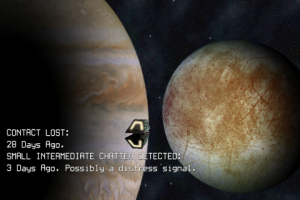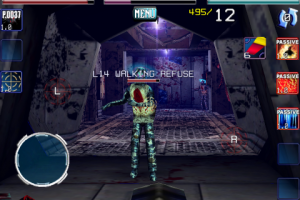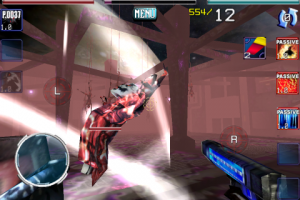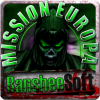In true sci-fi horror tradition, the intrigue in Mission Europa (Out Now, $9.99 Collector’s Edition, $3.99 standard edition + $2.99 IAP all episodes) began with scientists prying the lid off something humanity never should have gone anywhere near. A dropship packed with soldiers and researchers finally arrives to sort out what’s happened a month after the moon’s colony went silent. The fact that the spacefarers receive their post-hypersleep briefing while posed like Egyptian sarcophagi sets the game’s morbid tone, and it’s rather appropriate seeing as the ship gets blasted right out of Europa’s airspace. The player views subsequent events through the visor of the crash’s sole survivor, who takes orders from a damaged computer in hopes that repairs will allow it to access its own records regarding what happened on humanity’s coldest, most distant space outpost.
It’s not often I report that a game sports sub-par text quality and yet manages an involving story, but that’s precisely the case in Mission Europa. Its dialogue text could use a thorough once-over for punctuation and grammar, and in any case transitions so comically fast during cutscenes that the player doesn’t stand a shadow’s chance of reading through it all. Text aside, however, the cutscenes prove thoroughly intriguing and well-voiced. Mission Europa‘s quid-pro-quo model of storytelling – in which the mysterious supercomputer rewards successfully completed missions by furnishing its knowledge one video record at a time – feels refreshing even if its premise seems well-worn at first.
 Moreover, Mission Europa‘s plot manages twists early on that are interesting enough to keep the player engaged: machines run amok in Europa’s mines babbling psychotically and wearing the flesh of their victims like Hannibal Lecter wannabes; the supercomputer – seemingly the player’s only friend on this forsaken moon – begins dropping comments unsettling enough to make the player wonder whether the protagonist should really be continuing with the repair work after all. I couldn’t shake the feeling that this is how DOOM might have turned out had Arthur C. Clarke been handed scenario design responsibility.
Moreover, Mission Europa‘s plot manages twists early on that are interesting enough to keep the player engaged: machines run amok in Europa’s mines babbling psychotically and wearing the flesh of their victims like Hannibal Lecter wannabes; the supercomputer – seemingly the player’s only friend on this forsaken moon – begins dropping comments unsettling enough to make the player wonder whether the protagonist should really be continuing with the repair work after all. I couldn’t shake the feeling that this is how DOOM might have turned out had Arthur C. Clarke been handed scenario design responsibility.
Mission Europa looks like a First Person Shooter in screenshots, but it’s important to remember that its target demographic covers FPS and Action RPG fans equally — and far from clashing, the disparate gameplay mechanics complement one another in ways that give this game some of the strongest cross genre appeal I’ve yet seen on the iOS. Fetch quests, ever the bane of Action RPGs on this platform, feel more integrated than usual thanks to the plot style and combat rewards quick reflexes over button mashing. FPS fans might very well take a liking to all the status effects that help or hinder the player in realtime, as well as controlling how the protagonist’s strengths develop via equipment management and allocation of Level Up points.
 The player will spend most of his or her time in Mission Europa wandering through the titular moon’s 50-level mine shaft, which essentially serves as an expansive central dungeon. By the third floor or so the game dispels any notion that the setup lends itself to bland cookie-cutter level designs; the scientific team that preceded the player character’s arrival were apparently busy setting up intricate laboratories within the mine’s branching paths, and the enemies who have since taken up residence were much obliged to add their own macabre decor. Action RPG staples like detailed quest lists and minimap markers allow Mission Europa to effectively balance complex level design with clarity of player objectives. On the other hand, the game might have been better off without the slight random element in enemy and key item placement; I experienced one instance in which the game plopped an immovable quest related object right in the middle of a tight walkway, necessitating that I exit and re-visit that floor so its position would change.
The player will spend most of his or her time in Mission Europa wandering through the titular moon’s 50-level mine shaft, which essentially serves as an expansive central dungeon. By the third floor or so the game dispels any notion that the setup lends itself to bland cookie-cutter level designs; the scientific team that preceded the player character’s arrival were apparently busy setting up intricate laboratories within the mine’s branching paths, and the enemies who have since taken up residence were much obliged to add their own macabre decor. Action RPG staples like detailed quest lists and minimap markers allow Mission Europa to effectively balance complex level design with clarity of player objectives. On the other hand, the game might have been better off without the slight random element in enemy and key item placement; I experienced one instance in which the game plopped an immovable quest related object right in the middle of a tight walkway, necessitating that I exit and re-visit that floor so its position would change.
Given the mine setup the question of backtracking naturally arises, and in a move that can only be described as saintly, BansheeSoft pre-empts it completely with a very handy warp system. Good thing, too, because the game is absolutely humongous as it is. Each level of the mine shaft serves as the setting for one or more storyline quests, and takes about an hour to clear on average. Bonus levels gradually become accessible, offering additional side quests that net the player flashy summon attacks upon completion. Finally, rewards for number of kills made in a massively multiplayer arena will tempt the player into spending many hours virtually slaying (and trading items with) fellow iDevice owners. If Mission Europa has any single Achilles’ heel, it’s that some iOS gamers will feel intimidated by the sheer amount of content to be found within. Gamers who want to stretch the purchase price across weeks or even months, on the other hand, will be in heaven here.
 FPS fans will feel a bit hemmed in at first by how limited the player character’s initial firepower is — a mere four rounds between reloads doesn’t exactly lend itself to taking on entire crowds of enemies. Thankfully the player will end up sifting through a pretty formidable lineup of firearms with varying properties, clip sizes, and ammunition requirements over the course of the game, scavenged from fallen foes more often than not. One must also pay fair attention to melee weapons as an ammo-conserving measure, although Action RPG fans will miss the multi-hit combination attacks they’ve grown used to; the fun in Mission Europa lies in choosing the right weaponry for the situation and staying quick on one’s feet, not in executing flashy finishing moves.
FPS fans will feel a bit hemmed in at first by how limited the player character’s initial firepower is — a mere four rounds between reloads doesn’t exactly lend itself to taking on entire crowds of enemies. Thankfully the player will end up sifting through a pretty formidable lineup of firearms with varying properties, clip sizes, and ammunition requirements over the course of the game, scavenged from fallen foes more often than not. One must also pay fair attention to melee weapons as an ammo-conserving measure, although Action RPG fans will miss the multi-hit combination attacks they’ve grown used to; the fun in Mission Europa lies in choosing the right weaponry for the situation and staying quick on one’s feet, not in executing flashy finishing moves.
Weapons can be held in both the protagonist’s right and left hand – an attack virtual button is devoted to each arm – once he acquires a dual wielding skill. The player might sacrifice one weapon for a shield, raising it manually to ward off incoming projectiles. Viewpoint zooming has been incorporated as a hotlink-activated skill, so there’s plenty of sniping action to be had in addition to room-clearing energy blasts.
 Equipment management occurs through a reliable tap inventory interface, which includes a most welcome comparison feature that lets the player check whether stashed armor and weapons are superior to equipped counterparts. As a redundancy the player can open separate equipment and inventory menus and make use of drag-and-drop mechanics, but the reliability of this method seems spotty; there appear to be certain rules governing it that are unclear to the player. For example, I could drag items from the equipment menu into inventory for de-equipping, but failed to equip through the reverse process. This lack of clarity in drag-and-drop functionality also comes into play during the player’s attempts at item and skill combinations. While the game’s starting menu links to a tutorial video that covers these subjects, there’s currently no way of exiting an in-progress game on multitask-enabled iDevices; thus figuring out the quirks of drag-and-drop functions is a bit of a bore in Mission Europa as of this writing.
Equipment management occurs through a reliable tap inventory interface, which includes a most welcome comparison feature that lets the player check whether stashed armor and weapons are superior to equipped counterparts. As a redundancy the player can open separate equipment and inventory menus and make use of drag-and-drop mechanics, but the reliability of this method seems spotty; there appear to be certain rules governing it that are unclear to the player. For example, I could drag items from the equipment menu into inventory for de-equipping, but failed to equip through the reverse process. This lack of clarity in drag-and-drop functionality also comes into play during the player’s attempts at item and skill combinations. While the game’s starting menu links to a tutorial video that covers these subjects, there’s currently no way of exiting an in-progress game on multitask-enabled iDevices; thus figuring out the quirks of drag-and-drop functions is a bit of a bore in Mission Europa as of this writing.


